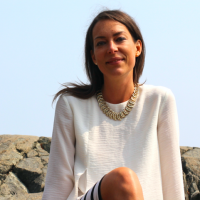It would be so easy to think that if we could just control our outer world, then we would be able to come to a place of equanimity in it—and within ourselves.
However, there are a few fundamental problems with this idea. First off, we cannot control what is happening outside of ourselves—and second, no matter what is going on in our exterior life, if our internal experience is not one of refuge, we will never feel “at peace,” nor will it.
The idea that we can work with life by fixing the exterior and then heading back and fixing the actual source of the problem is a western one. This technique is the Band-Aid approach to healing that much of North America has adopted.
We try to do it with medications that don’t heal the issue but simply manage symptoms. We attempt to do this with our bodies through surgery and diets. We try to make spaces that allow us to be at peace in a controlled environment with our air-conditioned homes and excessive collections of comfortable things to fill them.
Often though, even after the perfecting of our exterior state, there is a gulf of loneliness felt inside—restlessness and probably heartache too. When we realize we manipulated our world as much as we possibly could, and we are still not satisfied with it, what then do we do?
In the book Peace Is Every Step, the Dalai Lama says, “Peace must first be developed within an individual.”
I believe this is correct.
I have lived in incredibly gorgeous places—with spectacularly beautiful people, amazing food, and lifestyle opportunities—and have felt completely chaotic and violent inside. I have also lived in humble places, sharing a bed with a friend (because we had no money to rent our own) and eating the simplest of food, with little opportunity to do much but sit and breathe.
I can say that the latter example is the time I often felt the most at peace.
Some people believe it is selfish to invest time into spiritual or self-developmental practices like meditation or mindfulness. They have the opinion that it is self-centered to spend our time cultivating peace within, when there is so much need in the world for peace amongst others. However, perhaps it is impossible to be effective at cultivating world peace, unless we have become gentle and kind to ourselves first.
We don’t have to be perfect at finding peace within before we can help each other—but I do believe the more loving we are with ourselves, the more profoundly and honestly we can offer our assistance elsewhere. The world needs profound and honest help. It does not need more chaos.
This is what we are working on when we understand healing ourselves is healing the world. The Dalai Lama points out, “Although attempting to bring about world peace through the internal transformation of an individual is difficult, it is the only way.”
We must become gentle and tender with our own hearts—and forgiving and patient with our own minds—to be effective peace creators.
How do we do this? We just begin. We acknowledge that it is good work to nourish ourselves, and that true nourishment (and peace) begins when we slow down our habitual neurotic behaviors.
World renowned Zen master, Thich Nhat Hahn, writes continually about peace activism—and like the Dalai Lama, he promotes that we do this inside ourselves first.
He suggests that we begin by using everyday tasks to tap into mindfulness and satisfaction. He says that we begin with our first task of the day; we make tea (coffee) mindfully.
We do this act as if it was a meditation in motion. We become acutely aware of everything that is happening in the process. This brings us into the moment, which retrains us that in this second, we can feel free. Feeling freedom then informs us on how to help the world achieve theirs.
Making tea (or coffee) for peace.
When we turn on the tap to pour water into the kettle, think about where this water is coming from. What distance did it travel to get here? How grateful and lucky are we to have running water?
When the water is filling our kettle, what is the noise it is making? When it boils, does this sound change?
As the water is heating, can we notice our breathing as we wait? What is the quality of our breath? Can we observe our mind? Are our thoughts racing? Can we watch them like the weather as they pass?
When our tea (coffee) is ready, feel the whole experience of it. The sensation of the mug on our lips and in our hands. Is there steam rising? What is the taste? Is it sweet, strong, bitter, or mild?
Offer thanks that we had the opportunity to drink it and appreciate the moment mindfully.
Mindfulness is the key Zen practice to peace. When we truly notice what we are doing, how could we continue to cause ourselves (or another) harm? Instead, when we become more still in our internal world, we feel a sense of satisfaction in all things.
Realizing completeness within, through becoming present, allows us to then realize and manifest it on a broader scale. Perhaps, the way out of our own—and the world’s suffering—truly lies within.
~
Author: Sarah Norrad
Image: Flickr/Calsidyrose
Editor: Yoli Ramazzina











Read 0 comments and reply